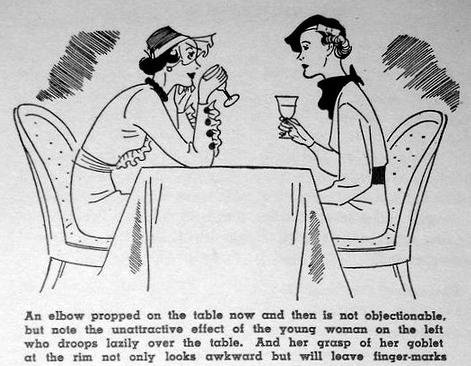1st: Every action done in company ought to be with some sign of respect to those that are present. — George Washington’s Rules of Civility & Decent Behaviour in Company and Conversation
Dear Etiquetteer:
I started following you after your etiquette dinner at [Insert Name of Local University Here] and I’ve had a blast reading about the marriage between historical and current etiquette. In a conversation with my friend about your page, we talked about how I recognized that my partner and I were engrossed in conversation over dinner (the kind of conversation that makes you put your utensils down because you just want to keep talking) and as soon as our utensils came down our elbows came up. In my parents’ home country, elbows aren’t a big deal and I never understood why Americans were so particular about that. What’s the deal with elbows? Where does that come from?
Dear Elbowed:
“Keep your elbows off the table” is one of the earliest lessons in table manners American children learn, along with “sit up straight.” Etiquetteer remembers a college classmate sharing the story of her grandfather telling her to keep her elbow off the table “or you’ll hurt the table fairies!” Her rebellion was to beat the table with her elbows whenever he wasn’t looking.
Researching Attitudes About Elbows, however, Etiquetteer has uncovered what feels like a mild deception in etiquette education. While children are taught to keep their elbows off the table at all times, adults may, sometimes, rest their elbows on the table between courses. “Elbows are universally seen on tables in restaurants,” wrote Emily Post Herself in the first edition of Etiquette, “as it is impossible to make oneself heard above the music by one’s table companions . . . without leaning far forward.” In which case, one needs elbow support. But she also notes “. . . the tolerated elbow-on-table is used only on occasion and for a reason, and should neither be permitted to children nor practised in their presence.”
Etiquetteer has come to the conclusion that any American emphasis about elbows comes from wanting to avoid both the appearance of gluttony and inconvenience to other diners. An instructive little volume from the 1880s called Don’t! includes this admonition: “Don’t spread your elbows when you are cutting your meat. Keep your elbows close to your side.” This makes someone look like they’re trying to claim more than their fair share of the meat, and of the table. If you’ve heard of manspreading on public transportation, this sounds like a dinner-table version of manspreading. Tiffany’s Table Manners for Teen-Agers explains it better: “Don’t stick your elbow out and raise your whole arm like a derrick.” That just looks like you’re greedy about your food, and it’s not a good impression to make on anyone.
Letitia Baldrige puts forward a sensible 21st-century attitude about elbows in her book New Manners for New Times: A Complete Guide to Etiquette: “It’s certainly all right to rest an elbow or two on the table between courses, because that’s a gesture that comes naturally to people engaged in animated conversation.” Just as you wrote you and your partner were doing at dinner! But Tish clarifies “While you are eating, though, it’s best to keep elbow off the table.”
For even more on the subject, Southern Living just published an interview on the subject with author Margaret Visser. It’s worth your time. Bon appétit!

